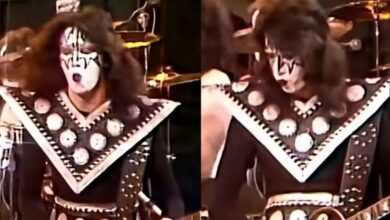A Timeless Anthem Reimagined: Ndlovu Youth Choir’s Vibrant Zulu Revival of “Bohemian Rhapsody”
The first impression hits like a burst of color — a legendary rock opera now shining with African rhythm and joy, as if Queen’s anthem had been reborn at a vibrant street festival. That exhilarating fusion defined the Ndlovu Youth Choir’s isiZulu reinterpretation of “Bohemian Rhapsody,” transforming one of rock’s most dramatic compositions into something celebratory and deeply human. Rather than simply covering the song, they reimagined it through Southern Africa’s choral heartbeat, blending Freddie Mercury’s theatrical ambition with the warmth and spirit of community harmony.
What stands out immediately is the freedom they bring to the music. Instead of treating the original as sacred ground, Ndlovu turns it into a living, breathing experience. The signature piano opening becomes a soft chorus hum, while the operatic passages rise through layered harmonies, syncopated rhythm, and clapping that gives the piece a heartbeat of its own. The grandeur remains, but it’s warmer now — familiar melodies carried by voices that feel alive and collective, reshaping Queen’s grandeur into something communal and joyous.
To fully appreciate their version, it helps to understand where the choir comes from. Emerging from Limpopo, South Africa, Ndlovu Youth Choir rose to international fame after their breakout performances on America’s Got Talent in 2019. Their energy, authenticity, and dazzling stagecraft captured the world’s attention. That journey—from a local youth program to a global stage—makes their take on “Bohemian Rhapsody” more than a musical experiment. It’s a declaration that African artistry stands proudly within the global canon, reinterpreting one of rock’s most beloved anthems through a lens of unity and renewal.
The release wasn’t just a quick viral hit; it was a carefully produced visual and musical statement. In the official video, every frame feels deliberate: colorful costumes shimmer against bold choreography, each movement synchronized to rhythm and emotion. The performance captures the song’s theatrical essence without imitating Queen. Instead, it invites the camera to move as if it were part of the dance itself — framing the choir’s smiles, gestures, and expressive storytelling that bridge language barriers through pure feeling and rhythm.
Behind this rendition was a meticulous creative process that balanced reverence and reinvention. The choir’s musical team approached Mercury’s complex lyrics with care, choosing what to translate into isiZulu and what to preserve in English. Recognizing that certain phrases—like “Scaramouche” or “Galileo”—carry musical rather than literal meaning, they retained them as anchors while reinterpreting the rest to fit the tonal richness of African languages. This decision gave the piece both authenticity and accessibility, turning translation into transformation rather than imitation.
When you listen closely, the fusion becomes clear. Traditional African choral styles like isicathamiya intertwine with call-and-response phrasing, replacing rock’s sharp edges with rhythmic sway. The middle operatic section expands beyond a single voice — it becomes a shared cry, a community lifting the melody together. Every breath, clap, and harmony contributes to a sense of vastness that redefines what “Bohemian Rhapsody” can be. Instead of echoing Mercury’s cathedral of sound through studio effects, they build it with human warmth and presence.
There’s a deeper resonance in this reimagining. Freddie Mercury himself was born in Zanzibar, and his global influences always shaped Queen’s sound. By giving “Bohemian Rhapsody” an isiZulu voice, Ndlovu completes a cultural circle, returning the song to the African continent through community and collective artistry. The performance feels like destiny — a half-century-old rock masterpiece reconnecting with its global roots, rediscovering rhythm, movement, and spirit in the hands of a new generation of storytellers.
Importantly, this wasn’t an unofficial experiment—it’s the first authorized Zulu-language version of the classic, approved by Queen’s team. That endorsement underlines the project’s artistic integrity. It wasn’t crafted to chase virality; it was meant to stand as a legitimate interpretation. It shows how timeless music evolves when passed through different cultures, proving that heritage and reinvention can coexist. The performance’s success demonstrates how a universal classic can find new resonance when spoken through another language’s rhythm and soul.
During the operatic passage, the choir displays astonishing precision. Each “mama mia” and “let me go” lands with perfect unity, but there’s joy instead of rigidity. Their faces beam with pride and delight, proof that discipline and passion can share the same stage. The moment embodies the choir’s philosophy: technical brilliance made accessible through human warmth. They turn virtuosity into inclusivity, inviting audiences into the experience rather than holding them at a distance in awe.
Because the lyrics flow between languages, emotion becomes the true translator. Listeners may not understand every word, yet they instinctively grasp the meaning through tone and delivery. Subtle gestures—a lifted hand, a softened vowel, a synchronized breath—carry emotional weight. The choir transforms individual confession into collective expression, making Mercury’s story of introspection into something communal. It’s no longer one voice crying out in the dark; it’s a chorus reminding us that humanity itself can sing through sorrow and triumph alike.
Credit must also go to musical director Ralf Schmitt, who posed a simple but profound question: what if “Bohemian Rhapsody” had been born in Africa? The answer unfolds in the arrangement’s hybrid structure, weaving local rhythms with modern choral complexity. Rather than copying Queen’s 1975 production techniques, the team channeled the spirit of innovation behind them. The result sounds fresh and daring, as if the song’s DNA had evolved naturally into a distinctly African soundscape, still grand but now full of sunlight and movement.
Released exactly fifty years after the original’s debut, the project feels like a celebration of endurance. “Bohemian Rhapsody” has survived generations of reinvention, and Ndlovu’s version proves that true art never stops growing. To see a South African youth choir take ownership of such a monumental song in the digital age—under the blessing of Queen’s legacy—shows that music’s greatest power lies in its adaptability. It’s no longer confined to one era or one sound; it continues to evolve, breathing new life through new voices.
The reception to this performance was immediate and emotional. Across social media and news outlets, fans called it both a tribute and a cultural milestone. The visuals—bold attire, joyful choreography, expressive storytelling—became symbols of how heritage and modernity can meet in perfect balance. Audiences praised the choir’s ability to honor the original while infusing it with authenticity, creating a version that felt both familiar and completely new. For many, it was a reminder of how creativity can bridge continents and generations.
What ultimately makes the rendition unforgettable is its emotional scale. Queen’s original was monumental, but Ndlovu’s interpretation adds intimacy and community. The climaxes feel larger not because of volume but because of unity—dozens of voices blending into one. The closing line, “nothing really matters,” becomes less of a lament and more of a peaceful affirmation. It’s proof that music’s greatest masterpieces are not static relics; they’re living entities, reborn each time someone dares to reinterpret them with sincerity and soul.
In the end, this performance isn’t just about reviving a song—it’s about redefining connection. Ndlovu Youth Choir turns “Bohemian Rhapsody” into a dialogue between cultures, between past and present, between Queen’s symphonic grandeur and Africa’s rhythmic heartbeat. It shows that greatness in music is never owned; it’s shared. And when shared with this much passion, grace, and authenticity, it reminds the world why art transcends boundaries and continues to evolve long after the final note fades.





